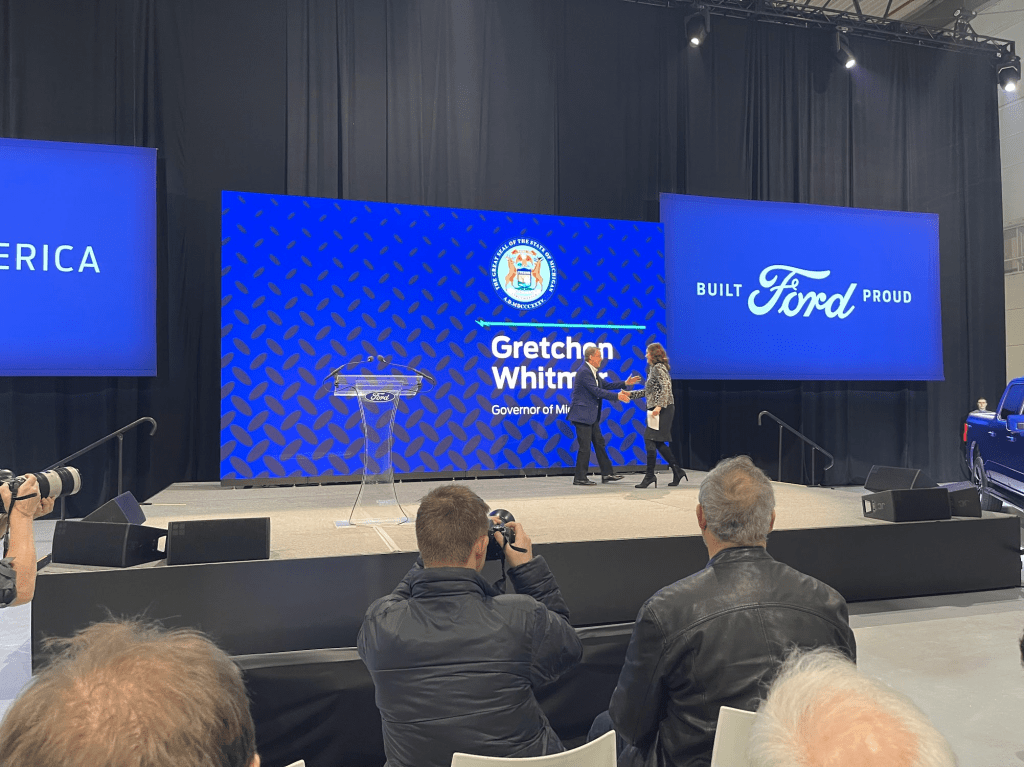
Ford F-150 Lightning manufacturing at Rouge Electric Vehicle Center (Source: Ford)
Ford today announced a significant move to LFP batteries for its electric vehicle line. The Dearborn company is tapping China’s CATL first for Chinese LFP batteries and then technology licensing for the previously rumored factory Ford plans to build in Michigan.
First, the numbers of the new Marshall, MI factory:
- 35GWh per year output in LFP batteries starting in 2026
- 400,000 vehicles in 2026. Ford plans on making 2M EVs in 2026 so that’s 20% of Ford’s global EVs getting batteries from the new plant.
- Doing the math, that means that Ford plans average-sized LFP batteries to be around 87kWh. That’s smaller than an F-150 Lightning battery but slightly bigger than a Mach-E Standard range. Ford says they are going to have a similar lineup profile in 2026 but the smaller sized packs could be offset by iterative efficiencies
- 2,500 new or transferring Ford US employees + unknown amount of CATL employees
Ford will receive LFP batteries from CATL’s Chinese factories that will go into standard range Mustang Mach-e’s later this year and Ford F-150 Lightnings starting in 2024.
LFP (lithium iron phosphate battery) vs. NCM (nickel cobalt manganese)
Ford is communicating that it needs to use two separate battery chemistries for two separate use cases. NCM, which Ford and other carmakers currently primarily use for higher range EVs, excel in power, speed, and cold weather performance. Meanwhile, LFP chemistry excels in cost, availability of materials, and life span.

Tesla for years now has taken advantage of LFP batteries from CATL for their standard range batteries, and Ford here is (relatively) fast following.
Ford’s new Mustang Mach-e standard range stands to gain some range from the LFP battery pack. During the presentation and subsequent Q&A, we got a good look at the new battery pack size, which read 78.21 kWh on 225Ah at 347.8V. The current standard range Mach-e is similar sized but only around 70kWh usable. With LFP, Ford will be able to use more of the total pack size and subsequently should have a longer range standard Mustang Mach-e.

Ford acknowledged that LFP cells are inherently safer than NMC and said that the pack safety requirements allowed them to build packs that would close the density gap somewhat. But don’t expect Ford to market these packs as “safer” while it still sells NMC pack vehicles.
Some other high level bullet points:
- Ford is the first automaker to commit to build both nickel cobalt manganese (NCM) and lithium iron phosphate (LFP) batteries in the U.S., helping America’s No. 2 EV company in 2022 bring EVs to more customers and diversify its U.S. supply chain
- Ford is investing $3.5 billion to build an LFP battery plant in Marshall, Michigan; this wholly owned subsidiary is part of Ford’s $50 billion+ global push to lead the EV revolution. Initial production slated for 2026 with 2,500 employees to start
- Adding LFP batteries to Ford’s EV lineup this year – starting with Mustang Mach-E – and backing a U.S. LFP battery plant are key parts of the company’s Ford+ plan; this helps Ford scale more quickly, making EVs more accessible and affordable for customers
- LFP batteries are exceptionally durable using fewer high-demand, high-cost materials and will help power a variety of Ford’s next-generation of EV passenger vehicles and pickups; new LFP plant will add approximately 35 gigawatt hours (GWh) of LFP battery capacity
- Ford and its battery tech collaborators have announced $17.6 billion in investment in EV and battery production in the United States since 2019, leading to more than 18,000 direct jobs in the U.S. and more than 100,000 indirect jobs
Electrek’s Take
A first for Ford building an LFP factory in the US is impressive, especially since Tesla has been building and importing Chinese CATL LFP cells packs for years. But Ford only hopes to reach 2 million yearly EVs by 2026. That’s about 2-3 years behind Tesla, which hopes to reach the milestone this year.
And who knows, Tesla could add LFP lines to one of its Gigafactories between now and 2026 relatively easily. But for now, let Ford have its first.

FTC: We use income earning auto affiliate links. More.



![Finance a new EV for less: EV deals with 0% interest this September [update]](https://i0.wp.com/electrek.co/wp-content/uploads/sites/3/2024/08/Polestar-first-electric-SUV-US-1.jpeg?resize=1200,628&quality=82&strip=all&ssl=1)
![This is it: the FIRST pure electric vehicle to wear a Lamborghini badge [video]](https://i0.wp.com/electrek.co/wp-content/uploads/sites/3/2025/09/lamborghini_pwc.jpg?resize=1200,628&quality=82&strip=all&ssl=1)

![Stellantis' new EV battery tech will put it ahead of – well, EVERYONE [video]](https://i0.wp.com/electrek.co/wp-content/uploads/sites/3/2025/09/Peugeot-E-3008_MAIN.jpg?resize=1200,628&quality=82&strip=all&ssl=1)





